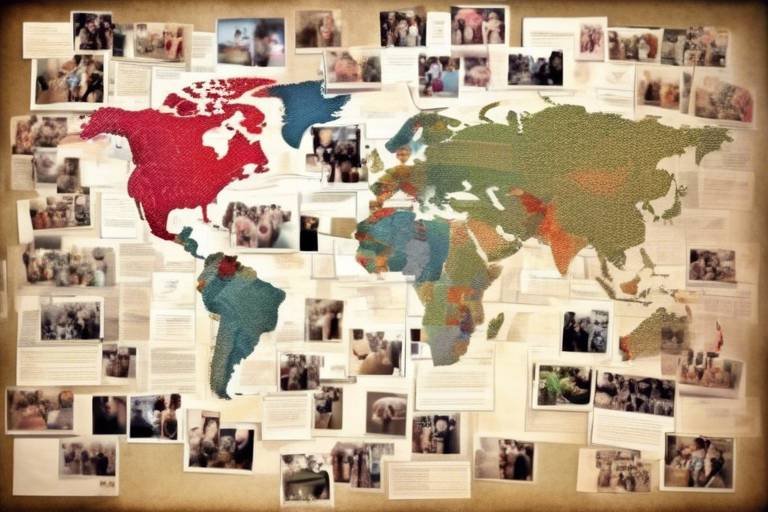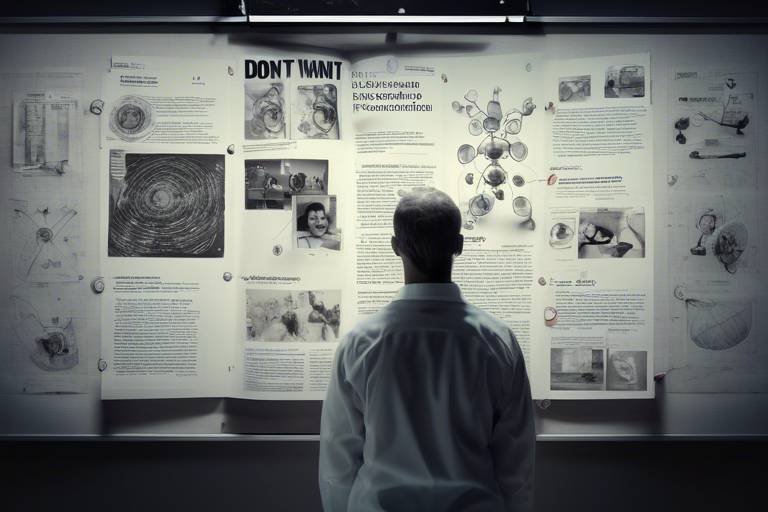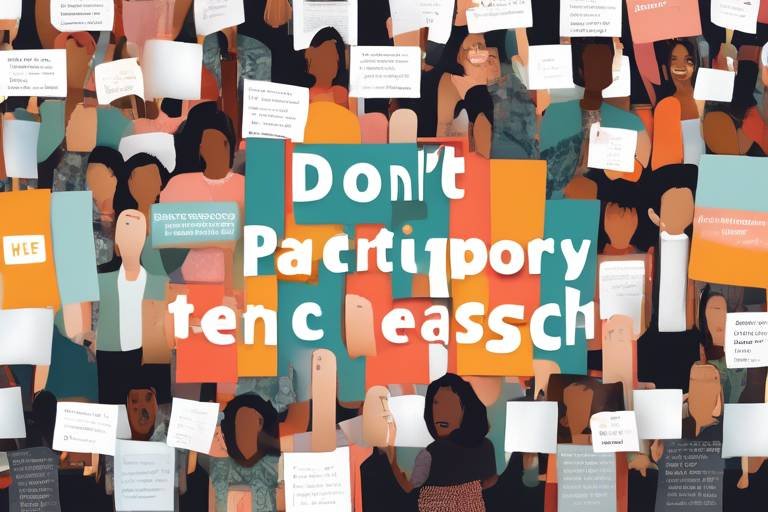How to Use Participatory Methods in Community Research
In today's rapidly evolving world, the importance of community involvement in research cannot be overstated. Participatory methods are not just buzzwords; they are powerful tools that transform the way we conduct research within communities. By actively engaging community members in the research process, we foster a sense of ownership and ensure that their unique insights shape the outcomes. Imagine being part of a team where your voice matters, where your experiences help guide decisions that affect your life. This is the essence of participatory research, and it opens doors to more relevant and impactful outcomes.
Participatory methods create a dynamic environment where researchers and community members collaborate, share ideas, and work towards common goals. This collaboration is not merely a checkbox on a project plan; it is the heart of effective community research. When communities are involved in the research process, they are more likely to embrace the findings and implement the recommendations. It's like having a co-pilot on a journey—when everyone has a hand on the controls, the destination becomes clearer, and the path more navigable.
To effectively utilize participatory methods, researchers must understand the various techniques available. Each method offers unique opportunities for engagement and insight gathering. From focus groups that encourage rich discussions to community mapping that visually represents local resources and challenges, these techniques are designed to engage community members actively. Think of focus groups as a potluck dinner where everyone brings a dish to the table—each person's contribution enriches the meal, creating a feast of ideas and perspectives.
However, it's not just about the methods themselves; successful implementation requires careful planning and a deep understanding of the community's needs. Researchers must select appropriate techniques that resonate with the community and train facilitators who can guide discussions effectively. This training is crucial, as it equips facilitators with essential skills such as active listening and conflict resolution. A facilitator is like a skilled conductor, ensuring that every musician in the orchestra plays in harmony, creating a beautiful symphony of voices and ideas.
Creating a supportive environment is equally important. Imagine walking into a warm, inviting space where you feel safe to share your thoughts and experiences. This atmosphere encourages openness and trust, which are vital for meaningful engagement. When community members feel valued and heard, they are more likely to participate actively, leading to richer data and insights. This collaborative spirit not only enhances research outcomes but also strengthens community bonds, fostering a sense of unity and shared purpose.
- What are participatory methods? Participatory methods are approaches that actively involve community members in the research process, ensuring their voices and insights shape the outcomes.
- Why are participatory methods important? They empower communities, foster ownership, and lead to more relevant and impactful research findings.
- What types of participatory methods are commonly used? Common methods include focus groups, community mapping, and workshops, each offering unique engagement opportunities.
- How can I implement participatory methods in my research? Successful implementation requires careful planning, selecting appropriate techniques, training facilitators, and creating a supportive environment.

The Importance of Participatory Methods
Participatory methods are not just trendy buzzwords in the realm of community research; they are essential tools that empower communities and transform the research landscape. By involving community members directly in the research process, these methods foster a sense of ownership and ensure that the voices of those most affected by the issues are heard loud and clear. Imagine a community where every individual feels valued and recognized; that’s the magic of participatory methods!
When communities participate in research, they bring forth their unique insights, experiences, and knowledge. This collaboration leads to outcomes that are not only relevant but also impactful. Instead of researchers imposing their views, participatory methods create a two-way street where information flows freely. This dynamic exchange enhances the quality of the data collected, ensuring it reflects the community's true needs and aspirations.
Moreover, participatory methods help build trust within the community. When individuals see their contributions valued and integrated into the research process, they are more likely to engage actively. This trust is crucial, especially in marginalized communities, where skepticism towards external researchers may exist. By fostering a sense of belonging and collaboration, participatory methods can turn research into a community-driven initiative rather than an outsider’s project.
In addition to trust and ownership, participatory methods also lead to more sustainable outcomes. When community members are involved, they are more likely to take action based on the findings. This active participation can lead to initiatives that address the identified issues effectively. For instance, if a community identifies a lack of resources for youth engagement, they are more inclined to develop programs or advocate for changes that reflect their needs.
Ultimately, the importance of participatory methods lies in their ability to create a more equitable research environment. They challenge traditional power dynamics, allowing for a more inclusive approach where everyone has a seat at the table. This shift not only enriches the research process but also cultivates a sense of community solidarity and shared purpose.
In summary, participatory methods are vital for ensuring that community research is not just a top-down process but a collaborative journey. They empower communities, enhance trust, and lead to outcomes that are relevant, sustainable, and impactful. By embracing these methods, researchers can unlock the full potential of community engagement, paving the way for meaningful change.

Types of Participatory Methods
Participatory methods are diverse and adaptable, each offering a unique lens through which communities can engage in research. These methods are not just tools; they are pathways that lead to deeper understanding and collaboration. By utilizing various participatory methods, researchers can tap into the collective wisdom of the community, ensuring that the research process is not only inclusive but also reflective of the community's true needs and aspirations. Here are some of the most common participatory methods:
One popular method is focus groups. These gatherings bring together a small group of community members to discuss specific topics in a guided manner. The magic of focus groups lies in their ability to facilitate in-depth discussions, allowing participants to share their thoughts, experiences, and feelings. This method captures a wide range of perspectives, generating rich qualitative data that can inform decision-making and policy development. Imagine a group of neighbors sitting around a table, sharing their stories and insights—this is where the real understanding begins!
Another effective method is community mapping. This technique invites participants to visually represent their community, highlighting important resources, challenges, and opportunities. Through community mapping, individuals can express their perceptions and experiences spatially, providing researchers with a clearer picture of the community dynamics at play. It’s like drawing a treasure map where the treasures are the strengths and assets of the community, and the challenges are the obstacles that need to be addressed.
Additionally, workshops serve as an engaging participatory method. Workshops can take many forms, from skill-building sessions to brainstorming activities, where community members collaborate to develop solutions to local issues. These interactive sessions not only foster creativity but also empower participants by equipping them with tools and knowledge that can be applied beyond the research context. Think of workshops as a community toolbox, where everyone leaves with not just ideas, but actionable skills.
In summary, the types of participatory methods available are numerous and varied. Each method, whether it’s focus groups, community mapping, or workshops, offers distinct advantages that can enhance community engagement and research outcomes. By selecting the appropriate participatory method, researchers can ensure that community voices are not just heard but are integral to the research process.
- What are participatory methods? Participatory methods are research techniques that actively involve community members in the research process, ensuring their voices and perspectives are included.
- Why are focus groups important? Focus groups allow for in-depth discussions and capture diverse perspectives, providing valuable qualitative data that reflects community needs.
- How does community mapping work? Community mapping engages participants in visually representing their environment, which helps researchers understand spatial dynamics and community resources.
- What skills are necessary for facilitators? Facilitators should be trained in active listening, conflict resolution, and inclusive participation strategies to effectively guide discussions.
- How can I create a supportive environment for participation? Establishing a safe and welcoming atmosphere encourages open sharing, fostering trust and collaboration among community members.

Focus Groups
Focus groups are an incredibly dynamic method for gathering insights from community members. They serve as a platform where individuals come together to discuss their thoughts, feelings, and opinions on various topics. Imagine a cozy living room filled with friends sharing stories over coffee; that’s the kind of environment focus groups aim to create, albeit with a more structured approach. By facilitating in-depth discussions, researchers can capture a rich tapestry of perspectives that reflect the community's needs and preferences. This method not only provides qualitative data but also enriches the research process by ensuring that diverse voices are heard.
One of the most exciting aspects of focus groups is their ability to foster open dialogue. Participants often feel empowered to express themselves, knowing that their contributions matter. This can lead to surprising revelations and insights that might not surface in more traditional research methods. For instance, during a focus group about local health services, one participant might share a personal story that resonates with others, sparking a conversation that uncovers shared challenges and potential solutions. This kind of synergy is what makes focus groups so valuable in community research.
However, like any method, focus groups come with their own set of challenges. Group dynamics can sometimes play a tricky role; for example, dominant voices may overshadow quieter participants, leading to an unbalanced discussion. Researchers must be vigilant and skilled in managing these dynamics to ensure that everyone has a chance to contribute. Additionally, logistical issues such as scheduling and location can pose hurdles that need thoughtful planning. Despite these challenges, the benefits of focus groups often outweigh the difficulties, making them a highly effective tool in community research.
To maximize the effectiveness of focus groups, researchers can implement several strategies:
- Establish ground rules: Setting clear guidelines for respectful communication can help create a safe space for all participants.
- Encourage participation: Using techniques like round-robin sharing can ensure that everyone has an opportunity to speak.
- Utilize skilled facilitators: Trained facilitators can navigate group dynamics and keep discussions on track.
In conclusion, focus groups are a powerful participatory method that can illuminate community issues in ways that other methods cannot. By harnessing the collective wisdom of community members, researchers can gain invaluable insights that lead to more effective and relevant solutions. Whether it’s about health services, educational needs, or social issues, focus groups can be the spark that ignites meaningful change.

Benefits of Focus Groups
Focus groups are a powerful tool in community research, offering a wealth of benefits that can significantly enhance the quality and relevance of research outcomes. One of the primary advantages of focus groups is their ability to foster open dialogue among participants. This dynamic interaction creates a space where community members feel comfortable sharing their thoughts, experiences, and ideas. Imagine a vibrant conversation where various perspectives come together, illuminating the multifaceted nature of community issues. This is precisely what focus groups facilitate.
Moreover, focus groups build trust among participants. When people engage in discussions about their community, they often find common ground, leading to stronger relationships. This trust is crucial, especially when addressing sensitive topics or issues that may affect marginalized groups. By providing a platform for these voices, focus groups ensure that everyone has a chance to be heard, contributing to a more comprehensive understanding of community needs.
Another significant benefit is the generation of rich qualitative data. Unlike surveys that may limit responses to predefined options, focus groups allow participants to elaborate on their thoughts. This depth of information can uncover insights that might otherwise remain hidden. For instance, a community facing challenges with local resources may express their frustrations and suggestions in a focus group setting, providing researchers with valuable context that numbers alone cannot convey.
Additionally, focus groups can be tailored to specific demographics or issues, making them highly adaptable. Researchers can conduct separate sessions for different age groups, cultural backgrounds, or community interests, ensuring that the discussions are relevant and inclusive. This adaptability helps in capturing a wide array of perspectives, enriching the overall research findings.
However, it’s essential to recognize that focus groups also come with their challenges, such as managing group dynamics and ensuring that dominant voices do not overshadow quieter participants. Nevertheless, with careful planning and skilled facilitation, the benefits of focus groups can far outweigh these challenges, making them an invaluable method in community research.
- What is a focus group? A focus group is a guided discussion among a group of individuals aimed at gathering insights and opinions on specific topics or issues.
- How do focus groups differ from surveys? Focus groups provide qualitative data through open discussions, while surveys typically gather quantitative data through structured questions.
- What are the key elements of a successful focus group? Successful focus groups require effective facilitation, a comfortable environment, and clear objectives.
- Can focus groups be conducted online? Yes, focus groups can be conducted virtually, allowing for broader participation and convenience.

Challenges of Focus Groups
While focus groups can be an incredibly effective tool for gathering insights, they are not without their challenges. One of the most significant issues that can arise is the dynamics within the group. When you gather a diverse set of individuals, each with their own perspectives and backgrounds, it can lead to a rich discussion. However, this diversity can also create tensions. For instance, a few dominant voices may overshadow quieter participants, leading to an incomplete picture of community sentiments. Imagine a vibrant party where only a couple of people are doing all the talking while others sit back, nodding along. This scenario can happen in focus groups, where the loudest voices drown out the more reserved ones.
Another challenge relates to the logistics of organizing focus groups. Coordinating schedules can feel like herding cats! Finding a suitable time and place that works for everyone is often a daunting task. If the environment is not conducive to open dialogue—think uncomfortable seating or distracting noises—participants may not feel inclined to share their thoughts freely. It’s crucial to create a space that feels safe and welcoming.
Moreover, researchers must be mindful of the facilitator's role. A skilled facilitator can make a world of difference, but if they are inexperienced or biased, it can skew the results. They need to balance guiding the conversation while allowing participants to express themselves fully. If they inadvertently steer the discussion towards their own interests or assumptions, the data collected may not genuinely reflect the community's views.
Lastly, it’s essential to recognize that focus groups can sometimes lead to superficial insights. While they can generate a wealth of qualitative data, the depth of understanding may vary. Participants may share their thoughts in the moment, but without proper follow-up or deeper exploration, those insights might not translate into actionable strategies. It’s like getting a taste of a delicious dish but never knowing the full recipe.
In summary, while focus groups are a powerful method for engaging communities and uncovering valuable insights, researchers must navigate challenges such as group dynamics, logistical hurdles, facilitator effectiveness, and the potential for superficial insights. By being aware of these challenges and proactively addressing them, researchers can harness the full potential of focus groups to inform their community research efforts.
- What are focus groups? Focus groups are guided discussions among a group of participants aimed at gathering diverse perspectives on a specific topic.
- How can I ensure all voices are heard in a focus group? Employ skilled facilitators, create a supportive environment, and use techniques like round-robin sharing to encourage participation from everyone.
- What should I do if a participant dominates the conversation? The facilitator should gently intervene, redirecting the conversation to allow others to share their views.
- How can I prepare for logistical challenges? Plan ahead by scheduling meetings well in advance, choosing accessible locations, and ensuring all necessary materials are prepared beforehand.

Community Mapping
Community mapping is a dynamic and engaging participatory method that allows individuals within a community to visually represent their surroundings. Imagine a blank canvas where community members can paint their experiences, challenges, and resources. This method not only captures the physical layout of a community but also encapsulates the emotional and social landscapes that define it. By utilizing tools such as maps, drawings, and digital platforms, participants can highlight important landmarks, identify areas of concern, and showcase opportunities for growth and development.
One of the most compelling aspects of community mapping is its ability to foster a sense of ownership among participants. When community members contribute to the mapping process, they feel a stronger connection to the outcomes. It's like giving them a microphone to amplify their voices, ensuring that their insights and experiences are not just acknowledged but celebrated. This collective effort can lead to a richer understanding of community dynamics, making the research process more inclusive and effective.
Moreover, community mapping can serve various purposes, such as:
- Identifying Resources: Participants can pinpoint local resources like parks, schools, and health facilities, which can help researchers understand the community's strengths.
- Highlighting Challenges: By marking areas of concern, such as crime hotspots or lack of access to services, community mapping can inform targeted interventions.
- Encouraging Collaboration: This method can bring together diverse groups within the community, fostering collaboration and dialogue among different stakeholders.
As researchers facilitate community mapping sessions, it’s essential to create an environment where everyone feels comfortable sharing their perspectives. This can be achieved through active listening and encouraging quieter participants to express their thoughts. The goal is to ensure that every voice is heard, and every perspective is valued. By combining visual representation with community input, researchers gain a comprehensive understanding of the community's needs and aspirations.
In practice, community mapping can take on various forms. For instance, some communities might prefer traditional paper maps, while others may opt for digital mapping tools that allow for real-time updates and collaboration. Regardless of the format, the essence of community mapping lies in its ability to bring people together, fostering a sense of belonging and shared purpose. Ultimately, it transforms the research process from a top-down approach to a more inclusive, bottom-up model, where community members are not just subjects of research but active participants in shaping their own futures.
1. What is community mapping?
Community mapping is a participatory method that engages community members in visually representing their environment, highlighting resources, challenges, and opportunities.
2. How does community mapping benefit research?
It enhances community engagement, provides rich qualitative data, and fosters ownership and collaboration among participants.
3. What tools are used in community mapping?
Tools can range from traditional paper maps to digital platforms that allow for collaborative mapping and real-time updates.
4. How can I get involved in community mapping?
Look for local community organizations or research initiatives that focus on participatory methods. They often host workshops and sessions where you can contribute.
5. What challenges might arise during community mapping?
Challenges can include ensuring that all voices are heard, managing group dynamics, and addressing logistical issues, such as access to mapping tools.

Implementing Participatory Methods
Successfully implementing participatory methods in community research is like orchestrating a symphony; it requires careful planning, coordination, and a deep understanding of the community's unique rhythm. First and foremost, selecting the appropriate techniques is crucial. Researchers must consider the specific context and needs of the community. For instance, if the community is highly diverse, methods like focus groups might be ideal for encouraging a variety of voices. On the other hand, if the goal is to visualize community resources and challenges, community mapping could be the most effective approach.
Once the techniques are selected, the next step is to train facilitators. Effective facilitation is the backbone of participatory methods. Facilitators must possess skills in active listening, conflict resolution, and inclusive participation strategies. Imagine a facilitator as a skilled gardener, tending to a diverse garden. They must ensure that every plant (or participant) receives the right amount of sunlight (attention) and water (support) to thrive. This training can include role-playing scenarios, workshops on communication techniques, and even mentorship programs with experienced facilitators.
Creating a supportive environment is equally important. Establishing a safe and welcoming space encourages community members to share their thoughts openly, fostering trust and collaboration. This environment can be likened to a cozy coffee shop where people feel comfortable discussing their ideas and experiences. To achieve this, researchers can consider the following:
- Setting up the space in a way that promotes interaction, such as arranging chairs in a circle.
- Providing refreshments to create a relaxed atmosphere.
- Using icebreakers to help participants feel at ease and build rapport.
Moreover, it’s essential to communicate the purpose of the research clearly. When community members understand how their input will influence outcomes, they are more likely to engage actively. This transparency can transform participants from passive subjects into active contributors, making them feel like integral parts of the research journey.
Lastly, it’s vital to continuously evaluate and adapt the participatory methods being used. Gathering feedback from participants after each session can provide valuable insights into what worked well and what could be improved. This iterative process not only enhances future engagements but also demonstrates to the community that their opinions are valued and taken seriously.
1. What are participatory methods?
Participatory methods are research techniques that actively involve community members in the research process, ensuring their voices and perspectives shape the outcomes.
2. Why are these methods important?
They empower communities, foster ownership, and lead to more relevant and impactful research outcomes by integrating the insights and experiences of those directly affected.
3. What types of participatory methods are commonly used?
Common methods include focus groups, community mapping, workshops, and surveys, each tailored to engage community members effectively.
4. How can I ensure effective participation?
Effective participation can be ensured by selecting appropriate methods, training facilitators, creating a supportive environment, and maintaining open communication throughout the research process.

Training Facilitators
When it comes to implementing participatory methods in community research, the role of facilitators cannot be overstated. These individuals are the backbone of the process, guiding discussions, ensuring that every voice is heard, and creating a space where participants feel comfortable sharing their thoughts and experiences. effectively is crucial for the success of any participatory initiative, as they must be equipped with a diverse skill set that includes active listening, conflict resolution, and strategies for fostering inclusive participation.
First and foremost, facilitators need to master the art of active listening. This means not just hearing what participants say, but truly understanding their perspectives and emotions. Active listening helps to build rapport and trust, which are essential for creating an open and honest environment. When community members feel that their opinions are valued, they are more likely to engage fully in the process.
Furthermore, facilitators should be trained in conflict resolution techniques. In any group setting, disagreements may arise, and it’s vital for facilitators to navigate these situations with care. By addressing conflicts constructively, facilitators can help maintain a positive atmosphere and ensure that discussions remain productive. This involves recognizing the underlying issues that may lead to conflict and facilitating dialogue that encourages understanding and collaboration.
Another key component of training is teaching facilitators how to encourage inclusive participation. This means developing strategies to ensure that all voices are heard, especially those from marginalized or less vocal community members. Techniques such as small group discussions or anonymous feedback can empower quieter participants to share their thoughts without fear of judgment. A well-trained facilitator will know how to balance the dynamics of the group, ensuring that no single voice dominates the conversation.
To illustrate the importance of these skills, consider the following table that outlines the essential training components for facilitators:
| Training Component | Description |
|---|---|
| Active Listening | Understanding participants' perspectives and emotions to foster trust. |
| Conflict Resolution | Navigating disagreements to maintain a positive group dynamic. |
| Inclusive Participation | Encouraging all voices to be heard, especially marginalized ones. |
| Facilitation Techniques | Using various methods to engage participants and stimulate discussion. |
In addition to these skills, facilitators should also be trained in various facilitation techniques tailored to different community contexts. This might include methods like brainstorming sessions, world café discussions, or open space technology, each designed to stimulate creativity and participation. By having a toolkit of techniques at their disposal, facilitators can adapt to the unique needs of their community, making the research process more relevant and engaging.
Ultimately, investing in the training of facilitators is an investment in the success of participatory research. When facilitators are well-prepared, the entire community research process benefits, leading to richer insights, deeper engagement, and ultimately, more impactful outcomes for the community. So, if you’re looking to enhance your community research efforts, remember that the heart of participation lies in the hands of skilled facilitators!
- What are participatory methods? Participatory methods are collaborative approaches that engage community members in the research process, ensuring their voices and perspectives are integral to the outcomes.
- Why is facilitator training important? Training facilitators is crucial as it equips them with the skills needed to effectively guide discussions, resolve conflicts, and foster inclusive participation.
- How can I encourage participation from quieter members? Techniques such as small group discussions or anonymous feedback can help empower quieter participants to share their thoughts without feeling intimidated.
- What types of activities can facilitators use? Facilitators can use a range of activities, including brainstorming sessions, focus groups, and community mapping, to engage participants and gather insights.

Creating a Supportive Environment
Creating a supportive environment is not just a step in the process; it's the very foundation that holds everything together. Imagine walking into a room where everyone feels at ease, like a cozy cafe where the barista knows your name and your favorite drink. That’s the kind of atmosphere we want to foster in community research. When participants feel safe and welcomed, they are more likely to open up, share their thoughts, and engage in meaningful dialogue. This sense of safety encourages individuals to express their ideas without fear of judgment, making the research process richer and more authentic.
To achieve this, researchers can employ a variety of strategies. First and foremost, it’s crucial to establish ground rules that promote respect and confidentiality. Think of these rules as the unwritten laws of a friendly neighborhood; they help maintain peace and understanding. For example, participants should agree to listen actively when someone else is speaking, ensuring that every voice is valued. Additionally, it’s vital to remind everyone that there are no wrong answers—every contribution is important and contributes to the collective knowledge.
Furthermore, the physical setting plays a significant role in creating a supportive environment. A well-arranged space can set the tone for the entire discussion. Consider the following elements:
| Element | Impact |
|---|---|
| Comfortable Seating | Encourages relaxation and open conversation. |
| Natural Light | Creates a warm and inviting atmosphere. |
| Accessible Layout | Promotes inclusivity, allowing everyone to participate fully. |
In addition to the physical space, the emotional tone set by the facilitators is equally important. Facilitators should approach discussions with empathy and patience, actively listening to participants and validating their feelings. When participants see that their contributions are acknowledged, it cultivates a sense of belonging and community. It’s like being part of a team where every member’s skills are recognized—everyone wants to contribute their best.
Moreover, integrating icebreaker activities at the beginning of sessions can help ease tension and build rapport among participants. These activities can be simple yet effective, such as sharing personal stories or fun facts. It’s like the warm-up exercises before a big game; they help participants get comfortable before diving into deeper discussions.
Lastly, ongoing feedback is essential in maintaining a supportive environment. After each session, take the time to ask participants how they felt about the discussions. What worked well? What could be improved? This feedback loop not only helps refine future sessions but also shows participants that their opinions matter, reinforcing their sense of ownership in the research process.
In summary, creating a supportive environment is about more than just logistics; it’s about cultivating a culture of openness, respect, and collaboration. By paying attention to the physical space, emotional tone, and participant feedback, researchers can foster an atmosphere where everyone feels valued and empowered to share their insights. This, in turn, leads to richer data and more impactful research outcomes.
- What are participatory methods? Participatory methods are research approaches that actively involve community members in the research process, ensuring their voices and perspectives are integral to the outcomes.
- Why is a supportive environment important? A supportive environment encourages open communication, trust, and collaboration among participants, leading to more meaningful engagement and richer data collection.
- How can I ensure participants feel safe to share? Establish ground rules for discussions, create a welcoming physical space, and approach conversations with empathy and active listening.
- What types of activities can help break the ice? Simple icebreaker activities, such as sharing personal stories or fun facts, can help participants relax and build rapport before deeper discussions.
Frequently Asked Questions
- What are participatory methods in community research?
Participatory methods are approaches that actively involve community members in the research process. This means that instead of researchers simply collecting data from the community, they engage with the community to gather insights, foster ownership, and ensure that the voices of the participants are heard. It’s like a team sport where everyone plays a role, making the outcomes more relevant and impactful.
- Why are participatory methods important?
These methods are crucial because they empower communities. When people contribute to the research, they feel a sense of ownership and responsibility towards the outcomes. This involvement leads to richer data and more effective solutions that truly reflect the community's needs. Think of it as building a house: the more input you have from those living in it, the better it will suit their needs.
- What types of participatory methods can be used?
There are several types of participatory methods, including focus groups, community mapping, and workshops. Each method has its unique way of engaging community members. For instance, focus groups allow for in-depth discussions, while community mapping visually represents the community’s resources and challenges. It’s about finding the right tool for the job!
- What are focus groups, and how do they work?
Focus groups are small, diverse groups of community members brought together to discuss specific topics. They allow researchers to capture a wide range of perspectives and generate qualitative data that reflects the community's needs and preferences. It’s like having a roundtable discussion where everyone gets to voice their thoughts and ideas.
- What challenges might arise during focus groups?
While focus groups can be incredibly beneficial, they do come with challenges. Issues such as dominant voices overshadowing quieter participants, group dynamics, and logistical hurdles can affect the outcomes. It’s essential for researchers to be aware of these challenges and navigate them skillfully to ensure everyone’s voice is heard.
- How does community mapping work?
Community mapping involves participants visually representing their environment, showcasing resources, challenges, and opportunities within their community. This method provides researchers with a spatial understanding of community dynamics, making it easier to identify areas that need attention. Imagine creating a treasure map where every ‘X’ marks a valuable insight!
- What is required to implement participatory methods effectively?
Implementing participatory methods successfully requires careful planning. This includes selecting the appropriate techniques, training facilitators, and creating a supportive environment for open dialogue. It’s all about laying the groundwork to foster trust and collaboration among community members.
- Why is training facilitators important?
Effective facilitation is key to participatory methods. Facilitators need to be trained in skills like active listening, conflict resolution, and strategies for inclusive participation. A well-trained facilitator can make all the difference, ensuring that discussions are productive and that everyone feels comfortable sharing their thoughts.
- How can a supportive environment be created for community engagement?
Creating a supportive environment involves establishing a safe and welcoming space where community members feel encouraged to share openly. This can be achieved through clear communication, building rapport, and ensuring that everyone’s contributions are valued. It’s like hosting a dinner party where everyone is invited to share their favorite dish!



















